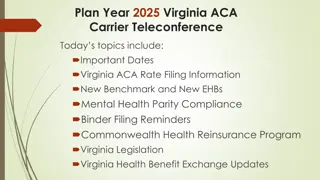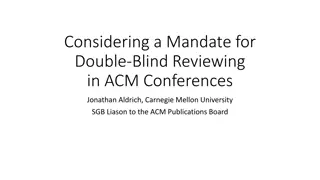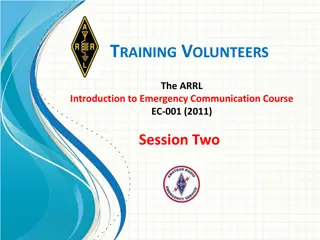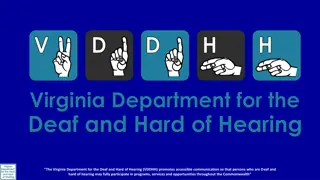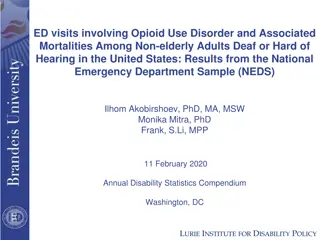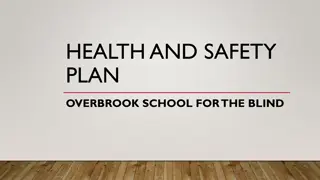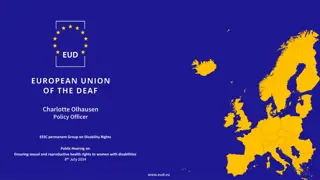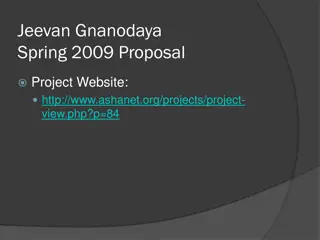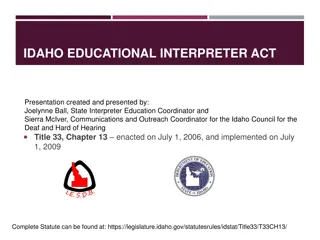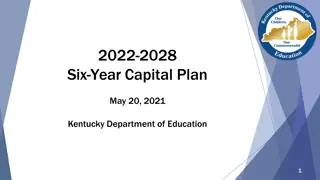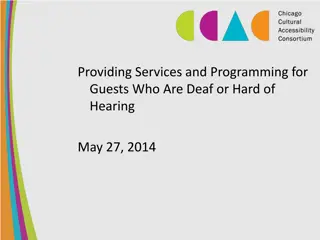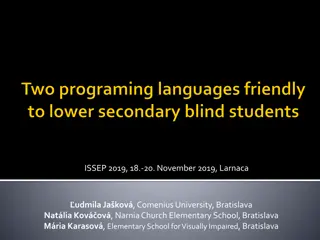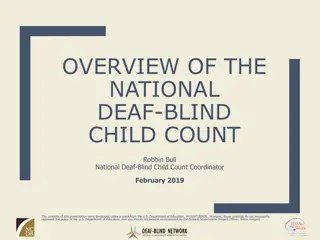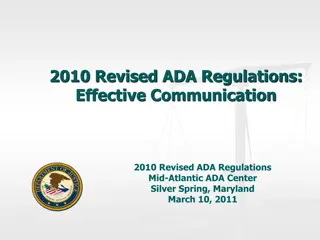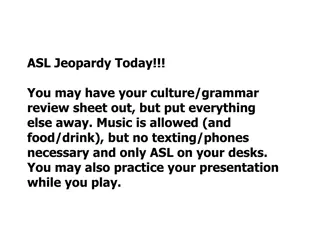Enhancing Emergency Communication Access Plan at Virginia School for the Deaf and the Blind
Virginia School for the Deaf and the Blind (VSDB) is taking steps to improve its emergency communication access plan to ensure all individuals on campus, including those who are deaf, hard of hearing, blind, or vision impaired, have full access to emergency alerts and instructions. The plan includes implementing a modernized system with features such as stack lights for visual notifications, auditory instructions, and a control system to switch to emergency notification mode automatically in various campus areas. VSDB aims to enhance crisis communication analysis, establish emergency response procedures for potential crises, and identify effective methods to communicate immediate actions for different types of emergencies.
Download Presentation

Please find below an Image/Link to download the presentation.
The content on the website is provided AS IS for your information and personal use only. It may not be sold, licensed, or shared on other websites without obtaining consent from the author.If you encounter any issues during the download, it is possible that the publisher has removed the file from their server.
You are allowed to download the files provided on this website for personal or commercial use, subject to the condition that they are used lawfully. All files are the property of their respective owners.
The content on the website is provided AS IS for your information and personal use only. It may not be sold, licensed, or shared on other websites without obtaining consent from the author.
E N D
Presentation Transcript
Emergency Communication Access Plan The Virginia School for the Deaf and the Blind
VSDB Current State Vs. Future State Current State Includes Stack Lights for visual notification as well as auditory instructions
VSDB Future State After reviewing past events and drills, VSDB has identified the need for a more enhanced and effective system. VSDB is continually assessing the communication needs of all individuals. As a result, we are in the process of modernizing our system and making every reasonable effort to ensure all people on the campus have access to full and effective emergency communication alerts and instructions. As a result, our future state will include:
Overview of the VSDB Crisis Communications Analysis: Who needs full access to emergency communications? Staff Students Parents/visitors/vendors Who may encounter barriers to standard communications? Individuals who are Deaf or Hard of Hearing Individuals who are Blind or Vision Impaired Individuals with other disabilities that may create challenges to processing auditory only communications
Continued: Establish Emergency Response Procedures for Potential Crises Fire Severe Weather/Tornado Earthquake Shelter -in -place (chemical or gas leaks) Armed Intruder Neighboring Community Crisis
Continued: Identify effective methods to communicate immediate actions to take for each type of emergency Fire Alarm should already be managed through an approved fire alarm system in each building. Each different type of crisis may require a different response. Education and training for each is vital to being prepared Utilize devices that show a PROMINENT Color for the different Emergencies in addition to wording can help to quickly cause an appropriate response for those that may be DHH So, where are we going?
Using a Control System to causes multiple subsystems to automatically switch to emergency notification mode All assigned computers will automatically display emergency information, background screen color will change to display corresponding emergency color Classroom Promethean Instructional Panels switch over (functions like a 70 computer tablet) Monitors placed in public areas/ hallways activate with audio and visual messaging Ability to reach effected audiences through text messaging. Supports the entire campus, including the urban farm and athletic fields. Provides increased access sites to initiate an emergency alarm.
Additional topics posed to Hands and Voices Are there specific things we should be putting into our children s IEP/504 plans? The safety portion of an IEP should address all sensory impairments or sensitivities; physical or mobility issues; varied level of coping skills, etc. This can help you to deal with the same issues at home and in the community.
What questions should we be asking our schools about their safety and having access for communication during these types of events? Participate in the IEP process and ensure there is a focus on safety that addresses any issues and concerns you may have; Question to understand how emergencies are communicated and what are the backup methods if the primary method fails; What are the parent/guardian notification protocols; Inquire if your school has a team assigned to study safety and follows standards established by the Department of Criminal Justice Service, School and Campus Safety Division. We would guess that your school has this team.
Additional topics continued What if children are in a bathroom? Most buildings have established and trained personnel to make a sweep through their floor or wing to check all spaces to determine that an evacuation is complete before they leave the floor. This should include restrooms, locker rooms, and other spaces. Teachers and administrators should have roll call sheets they take with them to assembly areas to account for all students, and to notify the incoming incident commander immediately if any people are unaccounted for.
QUESTION posed to Hands and Voices: What are school systems using to alert deaf/hard of hearing students lockdowns, fire drills,...? RESPONSES: 2. My school installed flashing blue light system in the SC classrooms used primarily by deaf and hard of hearing students as well as cafeterias, workroom used by deaf staff and conference room. The color blue indicates that it s a lockdown drill and not a fire drill which is red. VSDB experience has shown that visual displays, including a color that is specific to a type of emergency greatly helps in communicating with our DHH population. The key is not so critical as to which color is used, but that the school trains and teaches the meaning to all occupants. It is beneficial if the school uses codes or colors that are found in the community, as each locality may have a predetermined standard.
Follow Up to questions asked during the presentation: Q. Who is our Blast System with? A. Blast is the text messaging system we use to communicate emergency as well as routine business information to several predetermined distribution lists. The company we chose is Blackboard Connect. Q. What vendors are there for Mass Communication ? A. The major fire alarm companies are at the forefront of developing the future state. Our current system was built by Johnson Controls, Inc. Other major vendors are Siemens, Honeywell, Edwards, and Factory Mutual
VSDB is moving to a new style of mass communication, where a vendor will come in a capture several systems and cause them to convert to emergency communication mode. The system will use our computer network to send messages to all computers on campus, classroom educational boards, remote monitors, send text messages, etc. There are many vendors out there that are becoming proficient in interconnecting various systems. VSDB has received guidance form an integration company called Layered Solutions . Siemens Inc. is providing similar service through their Building Automation System
Questions continued: Q. What case law is out there to help us look into this? A. We, at VSDB, do not have much experience with any case law information. The main resource available to all is through the Virginia Department of Criminal Justice Services, School and Campus Safety Division. Their web page address is DCJS.Virginia.gov Discussion about understanding what my child s school is doing for safety: Schools are required to conduct formal safety reviews, and every 3 years, the process must include participants from the local police, fire, and EMS agencies, as well as teachers and parents and additional community resources, like mental health.


